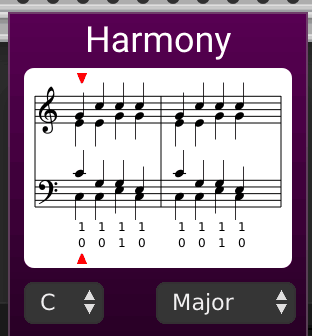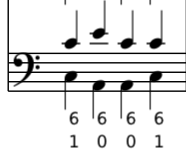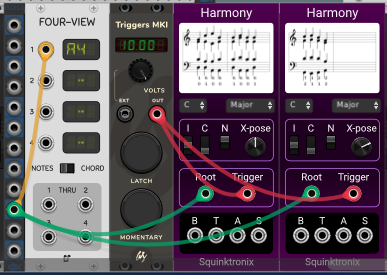- I actually had modern music theory text books in college. I picked this up later, because everyone said I should. I only used once in a while.
Some feedback. ![]() This is using Squinktronix Harmony 2.2.0 in VCV Rack 2.4.1 on an Intel Mac running macOS 14.1 (23B74).
This is using Squinktronix Harmony 2.2.0 in VCV Rack 2.4.1 on an Intel Mac running macOS 14.1 (23B74).
1: Very fast CV changes on startup
When Rack launches with a patch using Harmony which was open on last use of Rack, Harmony seems to generate very fast CV changes for about a tenth of second before settling down. When connected to pitch inputs on sound generating modules it makes a sound a bit like old modems spluttering and wheezing.
Example patch: harmony1.vcv (2.4 KB) (Please ignore the Stages / Segment Generator module in that patch. I forgot to remove it before uploading. Oops!)
This seems to happen regardless of whether Root and / or Trigger are patched, or the settings of the three switches and transpose parameter.
2: Request for CV control of the three switches and the transpose parameter
I’d really like it if those switches and the transpose parameter could be CV controlled. That way I could control those settings using a module like Audible Instruments Keyframe/Mixer (Frames) to perform / move into different areas of notes and what not.
I love it! Not played with the other modules yet.
I’ll check out that bug - that sounds bad.
I have to confess I’m slightly reluctant to add much more in the features department. I had (foolishly?) considered this module “done” when I tested it a year and a half ago. So I don’t really want to do major changes to the panel or the (complex!) algorithms in there.
That said, I do want to address some of the really compelling (to me) feedback. So CV for transpose, choice of sharps and flats, improve/fix the basic harmony rules - those are then ones that I’m considering “next”.
btw, on a small issue, I noticed that when you see Harmony in the browser, it populates the screen with a full 8 chords (I should know - I put those in there). But when you insert it in a patch it immediately goes to a c-major chord. As an experiment, I made it keep the 8 chords until you patch it. But maybe it would be better just blank until you patch it? suggestions appreciated.
What would cause the screen to “unblank” and show a chord / chords? Patching a cable into the Root input?
I don’t mind with just the one chord showing, either immediately when the module is added to the patch or when the screen “unblank” happens.
If the screen fills with eight chords when the module is added to a patch, would you need to add some kind of indicator to make clear that you’re “on” the first chord. (Little red arrows in image below.) Would that indicator then need to move along the stave to show which chord is currently playing?

Though, not sure how that would look when the screen resets to start drawing the next eight chords, as they get currently drawn one by one.
But not sure if you can draw all “future” eight chords in advance, so then the indicator idea wouldn’t be any use.
(Other thing is maybe randomise the diatonic mode the first time an instance of the module is added to the patch? That might help people not be “stuck” C major as the default?)
good points. that initial display is just decoration, so what happens now is that the module comes up, sees zero volts, and says “ah, I see a C note”, and clears the decoration, inserts the c chord. Might be best to have it come up totally blank, as the decoration is at best confusing (in my version where I preserved it).
Stoermelder uMap works fine for CV controlling each of the Harmony panel parameter controls for the present until such time and if you add CV control inputs. I’m actually having some fun sending a constant Root note to Harmony and just CV varying the parameters. I usually manually map out modules’ parameter “eigenstates” and CV “eigenvalues” so that I can CV sequence the module as desired.
Could you be more specific on how to repro this? Could you make a patch to show it using only VCV modules? My development environment does not download modules from the library, so when I load your example patch there is almost nothing in it.
btw, I am copying these bug reports to github. If it’s easy for you, could you update things there? If not, that’s fine. Here’s where I put your bug report: Very fast CV changes on startup · Issue #15 · squinkylabs/SqHarmony · GitHub
I downloaded Alan’s patch this morning under Windows and I hear what I think they are reporting. But, I think it is just normal startup stuff where inputs with zero volts on them result in C playing and there is a split second before things settle down. I suspect that part of the problem may be due to using the mixer as a VCA and it starts off with the amplitude high for just just a bit. But, I may be wrong.
It appears the startup noise originates in the Audible Instruments Random Sampler module. If I bypass it and save the patch and reload, the noise is not present at startup. That is the only module I can bypass and have the noise go away on startup.
I played a bit with Harmony and Arpeggiator today
although I have no knowledge about the theoretical background of these modules I like what they do ![]()
Then you are are my “target audience”. Thx!
Yes, my old version of Piston has this same exception - I’m not surprised this old chapter has not changed much!
Anyway, I don’t quite understand the exception. It says “leading tone goes up, the other 2 voices go down”. That only sounds like three voices - what happens to the fourth.
I would for sure like to “fix” this rule, but I don’t fully understand what the exception actually is.
Update: Ok, my piston book says that in the VI chord the 3rd is doubled, so that all makes sense. I think I got it now!
I don’t know if that is such a good idea ![]() Without the melodic minor it’s kind of hopeless, isn’t it? At the very least it is much more complicated. Let’s get major working first, yes?
Without the melodic minor it’s kind of hopeless, isn’t it? At the very least it is much more complicated. Let’s get major working first, yes?
as said, it is a Rule, with capital R ![]()
that’s because the Bass is already given.
usually as a beginner you are given a bass track and you have to complete it with the 3 upper voices. a second exercise could be that you are given a chord succession and you have to write all 4 voices. on a more advanced exercise you are given a soprano melody and you have to choose the harmony and write the 3 lower voices. these 3 skills (at basic level) are needed to go on with 7ths, 9ths and so on, before starting again from (almost) the basics and going deeper to understand better voicing movements (putting in 7ths, 9ths and so on). only then you can start studying counterpoint and composition (in a traditional way), but that becomes naturally a more student/master exchange than an IF/THEN/ELSE book of rules.
that’s how we are taught in Italy, I lost my train to go abroad last year (at 40 yo LOL)
yes of course, but I have to say that, even without thinking too deeply, mistakes are much more likely to happen in Minor mode, let’s see where we can go in Major mode first
What is the primary reason that Harmony does not have a Reset input? I was playing around with the manual mention of using the X-pose to raise a 2nd instance by a 3rd. That sounds good but I have no way to get the two instances synchronized. It probably doesn’t matter except as an aesthetic preference.
Also, what do the numbers under the score display mean? You told me once before, but I forgot. If this is mentioned in the manual, I am overlooking it.
Lastly, am I understanding the manual correctly that best results are obtained if a major scale is selected?

Ah, tx, I think I forgot to put that in the manual. I will enter a bug for that (just did). The top number is the scale degree, to that 6 is “the sixth” of the scale. In the case of maj it is A (if I got that right), so an a-minor triad.
The number below it is the inversion. 0 is root position, 1 is first inversion, 2 is second inversion.
Yes, as the manual mentions all these “rules” are the old rules for major scale. When you set other modes many of the rules don’t make sense. But hopefully the results with “sound good” to many ppl ![]()
I’m not sure what you mean by reset - what exactly would it do? There is a “trigger” input that will cause a new chord to be generated. It sounds like maybe that’s what you want?
Hmmm… would it be good to have a change in transpose always generate a new chord? Maybe not - if you don’t want to head the “in between” values…
As you can see below, I have two instances of Harmony that I am triggering manually for testing. After I mess around with X-pose, the two scores do not show the same number of notes. I have to reload the patch to get them in sync again. Reinitializing the the modules will not get them in sync.

I think that is what it is doing that is confusing me. It is not a big deal, just confusing from an aesthetic standpoint.
Oh! reset the note displays. Yes, I get it. Logged it in github.
Do you agree that Am scale will be harmonized “correctly”? It appears to be via my testing. Actually, any mode with it’s natural tonic will be okay, will it not? E.G., D-Dorian, etc.?
